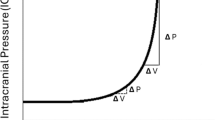Abstract
Introduction
Chronic overdrainage affects shunted patients producing a variety of symptoms that may be misdiagnosed. The best known symptoms are so-called shunt-related headaches. There is mounting evidence that changes in cerebrospinal venous system dynamics are a key factor to the pathophysiology of chronic overdrainage syndrome.
Clinical presentation
We report the case of a 29-year-old woman with a shunt since the postnatal period suffering from chronic but the most severe intermittent headache attacks, despite an open shunt and with unchanged ventricular width during attacks. Intracranial pressure (ICP) recordings were performed during headache attacks and thereafter.
Diagnosis and managment
Massively increased ICPs, a continuous B wave “storm,” and severely compromised intracranial compliance despite an open shunt were found, a scenario that was always self-limiting with the resolution of symptoms after several hours. When mobilized to the upright position, her ICPs dropped to − 17 mm Hg, proving shunt overdrainage.
Outcome and conclusions
Symptomatology can only be explained by sudden venous entrapment following chronic venous distention as a result of chronic overdrainage. Subsequent therapeutic management with an overdrainage preventing shunt and satisfying clinical outcome with complete ceasing of headache attacks adds insight into the pathophysiology of chronic overdrainage syndrome.





Similar content being viewed by others
References
Al-Khan A, Shah M, Altabban M, Kaul S, Dyer KY, Alvarez M, Saber S (2011) Measurement of intraabdominal pressure in pregnant women at term. J Reprod Med 56(1–2):53–57
Andersen M, Juhler M (2014) Intracranial pressure following complete removal of a small demarcated brain tumor: a model for normal intracranial pressure in humans. J Neurosurg 121(4):797–801
Barami K, Sood S (2016) The cerebral venous system and the postural regulation of intracranial pressure: implications in the management of patients with cerebrospinal fluid diversion. Childs Nerv Syst 32:599–607
Barami K (2016) Cerebral venous overdrainage: an under-recognized complication of cerebrospinal fluid diversion. Neurosurg Focus 41(3):E9
Balestreri M, Czosnyka M, Steiner LA, Schmidt E, Smielewski P, Matta B, Pickard JD (2004) Intracranial hypertension: what additional information can be derived from ICP waveform after head injury? Acta Neurochir (Wien) 146(2):131–141
Barami K, Sood S, Ham SD, Canady AI (2000) Postural changes in intracranial pressure in chronically shunted patients. Pediatr Neurosurg 33(2):64–69
Chapman J, Adams M, Geha AS (1990) The relationship between ventricular fluid pressure and body position in normal subjects and subjects with shunts: a telemetric study. Neurosurgery 26(2):181–189
Czosnyka M, Pickard JD (2004) Monitoring and interpretation of intracranial pressure. J Neurol Neurosurg Psychiatry 75(6):813–821
Davson H, Hollingsworth JR, Segal MD (1970) The mechanism of drainage of the cerebrospinal fluid. Brain 93:665–678
Del Bigio MR (2002) Neuropathological findings in a child with slit ventricle syndrome. Pediatr Neurosurg 37(3):148–151
Engel M, Carmel PW, Chutorian AM (1979) Increased intraventricular pressure without ventriculomegaly in children with shunts: “normal volume” hydrocephalus. Neurosurgery 5(5):549–552
Fox JL, McCullough DC, Green RC (1973) Effect of cerebrospinal fluid shunts on intracranial pressure and on cerebrospinal fluid dynamics. 2. A new technique of pressure measurements: results and concepts. 3. A concept of hy-drocephalus. J Neurol Neurosurg Psychiatry 36(2):302–312
Hoffman HJ, Tucker WS (1976) Cephalocranial disproportion. A complication of the treatment of hydrocephalus in children. Chids Brain 2(3):167–176
Khorasani L, Sikorski CW, Frim DM (2004) Lumbar CSF shunting preferentially drains the cerebral subarachnoid over the ventricular spaces: implications for the treatment of slit ventricle syndrome. Pediatr Neurosurg 40(6):270–276
Kölegård R, Eiken O (2011) Distensibility in human veins as affected by 5 weeks of repeated elevations of local transmural pressure. Eur J Appl Physiol 111(12):3119–3125
Maset AL, Suriano LC, Monteiro R, Pinto JR, de Andrade JR, Mancini BM, Ramin SL, Moraes DF, Cavalheiro S (2014) Shunt implantations and peritoneal catheters: do not cut beyond 20 cm. Surg Neurol Int 5:130
Matsumoto K, Ohta M, Takeshita I (2002) Symptomatic spinal extramedullary mass lesion secondary to chronic overdrainage of ventricular fluid-case report. Neurol Med Chir (Tokyo) 42(3):140–142
Mokri B (2001) Spontaneous intracranial hypotension. Curr Neurol Neurosci Rep 1(2):109–117 Review
Moreno AH, Katz AI, Gold LD (1970) Mechanics of distension of dog veins and other very thin-walled tubular structures. Circ Res 27:1069–1080
Paramore RH (1913) The intra-abdominal pressure in pregnancy. Proc R Soc Med 6(Obstet Gynaecol Sect):291–334
Portnoy HD, Chopp M (1994) Intracranial fluid dynamics. Interrelationship of CSF and vascular phenomena. Pediatr Neurosurg 20(1):92–97
Rekate HL (1992) Brain turgor (Kb): Intrinsic property of the brain to resist distortion. Pediatr Neurosurg 18(5–6):257–262
Rekate HL (2008) Shunt-related headaches: the slit ventricle syndromes. Childs Nerv Syst 24:423–430
Ros B, Iglesias S, Mart n A, Carrasco A, Ibañez G, Arraez MA (2017) Shunt overdrainage syndrome: review of the literature. Neurosurg Rev. https://doi.org/10.1007/s10143-017-0849-5
Shapiro K, Fried A (1986) Pressure-volume relationships in shunt-dependent childhood hydrocephalus. J Neurosurg 64:390–396
Sood S, Kumar CR, Jamous M, Schuhmann MU, Ham SD, Canady AI (2004) Pathophysiological changes in cerebrovascular distensibility in patients un-dergoing chronic shunt therapy. J Neurosurg: Pediatrics 100(5 Suppl):447–453
Weerakkody RA, Czosnyka M, Schuhmann MU, Schmidt E, Keong N, Santarius T, Pickard JD, Czosnyka Z (2011) Clinical assessment of cerebrospinal fluid dynamics in hydrocephalus. Guide to interpretation based on observa-tional study. Acta Neurol Scand 124(2):85–98
Wolfe SQ, Bhatia S, Green B, Ragheb J (2007) Engorged epidural venous plexus and cervical myelopathy due to cerebrospinal uid overdrainage: a rare complication of ventricular shunts. Case report. J Neurosurg 106(3 Suppl):227–231
Author information
Authors and Affiliations
Corresponding author
Ethics declarations
Conflict of interest
On behalf of all authors, the corresponding author states that there is no conflict of interest.
Rights and permissions
About this article
Cite this article
Sainz, L.V., Hockel, K. & Schuhmann, M.U. Chronic overdrainage syndrome: pathophysiological insights based on ICP analysis: a case-based review. Childs Nerv Syst 34, 401–408 (2018). https://doi.org/10.1007/s00381-017-3650-4
Received:
Accepted:
Published:
Issue Date:
DOI: https://doi.org/10.1007/s00381-017-3650-4




